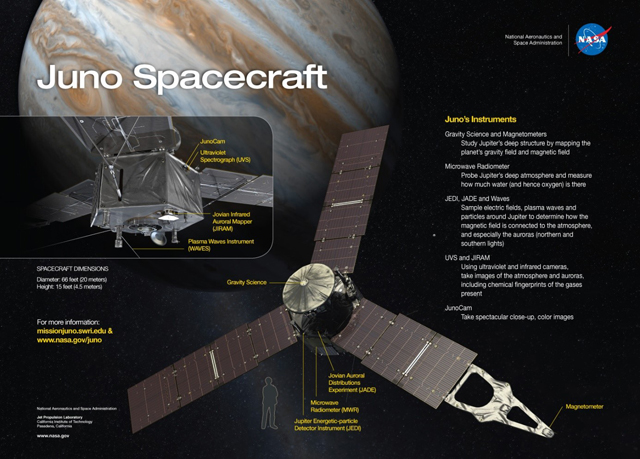NASA’s Juno Mission to Remain in Current Orbit at Jupiter

The original flight plan for NASA’s Juno probe called for the spacecraft to alter its current orbit, which takes 53 days to orbit Jupiter, into an orbit that would have circled Jupiter every 14 days. However, the Juno team has decided to abandon this plan and leave Juno in its current orbit after two helium check valves in the plumbing for Juno’s main engine failed to operate as intended when the propulsion system was pressurized in October. Telemetry from the spacecraft indicated that it took several minutes for the valves to open, while it took only a few seconds during past main engine firings. The decision is not expected to affect Juno’s ability to perform its primary science objectives.
“Juno is healthy, its science instruments are fully operational, and the data and images we’ve received are nothing short of amazing,” said Thomas Zurbuchen, associate administrator for NASA’s Science Mission Directorate in Washington. “The decision to forego the burn is the right thing to do – preserving a valuable asset so that Juno can continue its exciting journey of discovery.”
The Science of Jupiter
Filmed just before Juno entered orbit around Jupiter, members of the Juno team discuss science objectives.
Since its arrival on July 4, 2016, Juno has completed four orbits around Jupiter and its closest approach takes it 4,100 kilometers (2,600 miles) above Jupiter’s cloud cover. During these low passes, Juno can peer beneath the obscuring cloud cover and study Jupiter’s auroras to learn more about the planet’s origins, structure, atmosphere and magnetosphere. Since the planned adjustment to Juno’s orbit was reviewed and scrubbed as too risky to the spacecraft, the longer 53-day orbit allows for what a statement from NASA called “bonus science” that wasn’t in the original mission plan. Juno will further explore the far reaches of the Jovian magnetosphere – the region of space dominated by Jupiter’s magnetic field – including the far magnetotail, the southern magnetosphere, and the magnetospheric boundary region called the magnetopause. Understanding magnetospheres and how they interact with the solar wind are key science goals of NASA’s Heliophysics Science Division.
The Juno science team continues to analyze returns from previous flybys. Revelations include that Jupiter’s magnetic fields and aurora are bigger and more powerful than originally thought and that the belts and zones that give the gas giant’s cloud top its distinctive look extend deep into the planet’s interior. Peer-reviewed papers with more in-depth science results from Juno’s first three flybys are expected to be published within the next few months. In addition, the mission’s JunoCam – the first interplanetary outreach camera – is now being guided with assistance from the public. People can participate by voting on which features on Jupiter should be imaged during each flyby. The JunoCam is capable of capturing impressive imagery like the “cloud swirls” shown in the below video.
It’s also expected that the change could extend the life of Juno because it would spend less time in the intense radiation belts. The primary mission is expected to last 12 orbits — until July 2018 now that Juno will stay in its current orbit — and could possibly be extended if the probe remains in good condition.
“Juno is providing spectacular results, and we are rewriting our ideas of how giant planets work,” said Bolton. “The science will be just as spectacular as with our original plan.”
JPL manages the Juno mission for NASA. The mission’s principal investigator is Scott Bolton at Southwest Research Institute in San Antonio. The Juno mission is part of the New Frontiers Program managed by NASA’s Marshall Space Flight Center in Huntsville, Alabama, for the Science Mission Directorate. Lockheed Martin Space Systems, Denver, built the spacecraft. JPL is managed for NASA by Caltech in Pasadena, California.
Good Books To Read
More Jupiter and Juno on eBay
[ebayfeedsforwordpress feed=”http://rest.ebay.com/epn/v1/find/item.rss?keyword=%28jupiter+planet%2Cjupiter+probe%2Cjupiter+juno+probe%2CJunoCam%29&exclCategoryId1=11232&sortOrder=BestMatch&programid=1&campaignid=5337337555&toolid=10039&listingType1=All&lgeo=1&feedType=rss” items=”10″]







